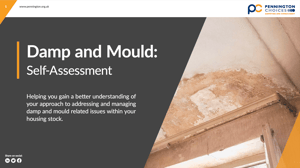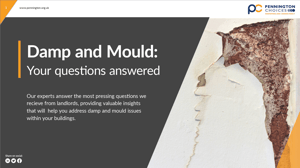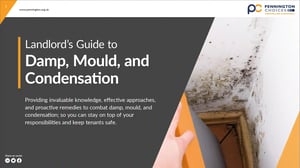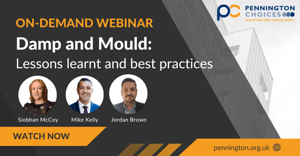Sign up to our newsletter
Last updated: 22nd December 2025
The persistent challenge of addressing, treating, and preventing damp and mould is a concern that demands attention. Following the government’s response to the coroner’s report into the tragic death of Awaab Ishak, several key pieces of guidance, including the long awaited Awaab's Law, have been published in hopes of transforming the sector and preventing similar avoidable tragedies from ever happening again. The main message from this guidance is loud and clear: in no circumstance should the sector be blaming ‘lifestyle’ for damp and mould issues. Landlords should not be complacent and must prioritise identifying underlying causes, ultimately finding long-term solutions.
Discover the top questions organisations across the sector are asking, including insights on Awaab's Law time frames, emergency hazards, and decanting residents in our recent webinar, 'Awaab's Law in Practice: Your Questions Answered', which is available on-demand now.
Let's take a deep dive into damp and mould in social housing so you can keep your properties and your tenants safe.
Understanding the cause and the impact
Understanding the root cause of damp and mould is imperative to effectively tackle it with lasting solutions. It also means you can organise targeted remediation, which is especially important since different causes of damp require different solutions. This not only addresses the damp and mould symptoms and immediate issue at hand, but also contributes to the overall health, safety, and longevity of your property.
The key is to stay vigilant and proactive when identifying damp and mould symptoms, investigating the root cause, and then implementing appropriate solutions. Common culprits of damp and mould include leaks, penetrating/rising dampness, inadequate ventilation and insulation, and inadequate heating. To be 100% sure of the cause and remedy to your damp and mould issues, we recommend engaging a qualified and competent expert surveyor to conduct a thorough damp and mould survey in your property. The survey will identify whether your building poses a potential health risk if damp and mould are present. It will also specify the remedial action required to address the risk, improve safety, and address the root cause(s).

To help you better understand your approach to damp and mould and identify any gaps in your compliance, download your free Damp and Mould Self-Assessment here.
Sector updates you should be aware of
Guidance published by the government in September 2023 aims to improve the standards in rented homes across England through the Social Housing (Regulation) Act 2023. This includes ‘Understanding and addressing the health risks of damp and mould in the home’, which outlines:
- The health risks of damp and mould
- Regulation on damp and mould in social and private rented properties
- Responding to reports of damp and mould
- Taking a proactive approach to reduce the risk of damp and mould
The government is also updating the Decent Homes Standard (DHS) and intends for it to apply across all rented tenures. This update is yet to be released and is now expected alongside the HHSRS review. The amendments will be across all four of the current criteria within the DHS:
- Updating the Housing Health and Safety Rating System (HHSRS). Introducing a specific damp and mould standard and bringing other physical decency requirements into the DHS.
- Amending the disrepair criteria, including removing the requirement for something to be ‘old’ to be broken.
- Reviewing the list of essential facilities to include requirements around ventilation, home security, and other issues, as well as reviewing the ‘rule of three’ which allows for some essential facilities not to be met.
- Considering possible measures related to climate change and environmentally sustainable behaviours, including thermal comfort in homes, insulation requirements, and introducing Minimum Energy Efficiency Standards for the social rented sector.
- Changes to the HHSRS will bring it up to date to reflect modern expectations and living standards, reducing the 29 hazards to 21 and implementing ‘indicative baselines’ to enable an initial assessment to determine whether serious hazards are present.
The HHSRS review is expected to come into force at the same time as the DHS review, drawing upon tenants' rights for damp and mould to improve the quality of housing and ensure all hazards are identified, categorised, and addressed. The review will include:
- Reducing the number of Hazards from 29 to 21
- Additional information around the baselines
- New statutory operating and enforcement guidance, with a new set of case studies
- Ensuring fire risks in tall buildings can be assessed effectively
- Simpler means of banding
- Reviewed training requirements
To discover expert insight into the basics of the HHSRS and find out what the upcoming changes mean for your organisation, watch our damp and mould specialists in our webinar, ' Housing Health and Safety Rating System (HHSRS) 101', on-demand now.
Awaab's Law
The much-anticipated Awaab's Law phase one is now in force. Under this legislation, social landlords must investigate reported damp and mould within fixed timescales and address all emergency repairs within 24 hours (whether they relate to damp and mould or any other hazards).
The second and third phase of Awaab's Law will be implemented in 2026 and 2027, extending the requirements to apply to a wider range of HHSRS hazards.
Read our dedicated blog, 'Awaab's Law: What to expect', to discover a comprehensive overview of the upcoming legislative changes to addressing damp and mould.
 Social housing landlords, do you have questions about what is on the horizon for damp and mould?
Social housing landlords, do you have questions about what is on the horizon for damp and mould?
Find the answers to all your damp and mould questions in one place when you download our free 'Damp and Mould: Your questions answered' e-book.
Tenants’ rights in the UK
"If you have damp and mould in your home, you're more likely to have respiratory problems, respiratory infections, allergies or asthma. Damp and mould can also affect the immune system."
Source: NHS
Across the UK’s social housing sector, tenants are gaining more power to hold their landlords to account for poor housing conditions and inadequate service delivery. The new consumer regulation regime will strengthen their rights and ensure that the Regulator of Social Housing also has additional enforcement power. The Social Housing (Regulation) Act 2023 is delivering reforms outlined in the Social Housing White Paper – The Charter for Social Housing Residents, published in 2020, which followed on from the findings and proposals in the Social Housing Green Paper: A New Deal for Social Housing in 2017. The government embarked on a ‘listening exercise’ following the Grenfell Tower fire in 2017 to engage with social housing tenants to hear first hand about their concerns, and the measures outlined in the Green Paper included providing greater redress, better regulation, and improving the quality of social housing.
The White Paper set out a Charter for what every social housing tenant should be able to expect:
- To be safe in your home. The government will work with industry and landlords to ensure every home is safe and secure.
- To know how your landlord is performing, including on repairs, complaints, and safety, and how it spends its money, so you can hold it to account.
- To have your complaints dealt with promptly and fairly, with access to a strong ombudsman who will give you swift and fair redress when needed.
- To be treated with respect, backed by a strong consumer regulator, and improved consumer standards for tenants.
- To have your voice heard by your landlord, for example through regular meetings, scrutiny panels or being on its board. The government will provide access to help, if you want it, for you to learn new skills to ensure your landlord listens.
- To have a good quality home and neighbourhood to live in, with your landlord keeping your home in good repair.
- To be supported to take your first step to ownership, so it is a ladder to other opportunities, should your circumstances allow.
The coroner’s verdict in November 2022 into the death of Awaab Ishak reinforced the need for the government to implement the intended reforms, and to bolster these with additional measures to respond to the lessons from the inquest.
Since then, the government has made several amendments to the Social Housing (Regulation) Bill which had been introduced to Parliament earlier in 2022 and has taken steps to educate and engage with tenants about their rights and how they can be empowered to raise concerns about the quality of their homes and services. To read more about what the Social Housing (Regulation) Act 2023 means for your tenants’ rights, click here.
Lessons learnt
Our lessons learnt from working with organisations to help ensure their HHSRS and damp and mould compliance have highlighted key areas that are important to consider:
- Damp and mould typically occurs in bedrooms around window seals and in bathrooms with a lack of effective or little ventilation.
- Despite bathrooms not being considered habitable rooms, the presence of damp and mould could warrant classification as a severe category 1 hazard. When scoring damp and mould, you must take into consideration the vulnerable group (under 15s) and the nature of a bathroom's moisture and temperature level varying throughout the day. Failure to address the damp and mould could result in rapid escalate to an uncontrollable level.
- Categorising damp and mould varies based on different factors. A small patch of mould in one property may be a category 1 hazard but the same size patch in another property may not be.
- Provide an honest evaluation of your internal resources. Ensure you have sufficient volume and the necessary skills, knowledge, and experience to address damp and mould issues. The best collaboration comes from organisations being honest with the areas that they require external help with.
- Be proactive, not reactive. This responsibility extends beyond surveyors to anyone entering the property from the housing association. They should be vigilant, asking the right questions and looking for signs of issues. Active communication with tenants is essential; their insights can be invaluable in diagnosing problems early.
- Use experienced, qualified surveyors. Ensure that both internal and external surveyors are qualified and experienced in handling damp and mould issues. You can refer to the government’s guidance on the recommended qualifications for damp and mould surveyors here.
- Quality assurance and auditing. Implement quality assurance and auditing for all reports, whether internal or external. A second review can often catch details that were initially overlooked.
- Follow a process - understand different types/tiers of survey. Adopt a systematic approach to handling damp and mould issues. Start with a compliant inspection and, if necessary, engage a third-party organisation for a more technical investigation.
- Follow up on surveys! Ensure thorough follow-up after surveys. This includes maintaining active communication, performing necessary immediate actions like a mould wash, and completing the recommended remedial work to resolve the issue effectively.
Discover how we helped Castles and Coasts Housing Association to identify and manage damp and mould hazards with tier two Damp and Mould Surveys here.
Your regulatory responsibilities
The legal and regulatory duties for property condition, which apply to damp, mould and condensation in your properties are as follows:
Landlord and Tenant Act 1985, as amended by Homes (Fitness for Human Habitation) Act 2018
Landlords must legally perform repairs in rental properties, adhering to minimum standards set by legislation like Section 11 of the Landlord and Tenants Act 1985. The Landlord and Tenant Act, as amended by the Homes (Fitness for Human Habitation) Act 2018, mandates that properties remain habitable throughout the tenancy, ensuring they are free from health-damaging dampness and HHSRS hazards that would render them unsuitable for habitation.
Housing Act 2004
The Housing Act 2004 introduced a new system to assess the condition of residential properties in England and Wales, including category 1 and 2 hazards. The HHSRS introduced 29 hazards and their descriptions, including damp and mould growth, along with excess cold. Landlords are required to make sure that properties meet the legal minimum standard for housing, which specifies that properties be free of category 1 hazards. This is enforced by local authorities, and they are obliged to consider housing conditions within their area and to identify and take appropriate action when they become aware of hazards.
To gain a comprehensive understanding of the basics of the HHSRS, including categorising and scoring damp and mould, download our free 'Guide to the Housing Health and Safety Rating System (HHSRS)' here.
Decent Homes Standard
To meet the Decent Homes Standard, properties must:
- Meet the current statutory minimum standard for housing (HHSRS) and be free from category 1 HHSRS hazards.
- Be in a reasonable state of repair, meaning key and other building components must not be old and in need of replacement of major repair due to their condition.
- Have reasonably modern facilities and services.
- Provide a reasonable degree of thermal comfort, requiring dwellings to have effective insulation and heating.
Regulator of Social Housing Consumer Standard: Home Standard
The Regulator of Social Housing sets out standards that social landlords need to meet, with the Home Standard setting the requirements for property quality. Under the Home Standard landlords need to make sure that they are meeting all applicable statutory requirements around health and safety within tenant’s homes.
Social Housing (Regulation) Act 2023
As of 20th of July 2023, the approved Social Housing (Regulation) Act 2023 aims to improve social housing quality by delivering ‘transformational change’ for social housing tenants. This will enable the regulator to implement a new, proactive consumer regulation regime that will enhance sector standards and ensure tenants’ rights and needs are prioritised.
 For more info on the other changes to your regulatory responsibilities, including the changes to damp and mould regulation over the years, download your FREE landlord’s guide here.
For more info on the other changes to your regulatory responsibilities, including the changes to damp and mould regulation over the years, download your FREE landlord’s guide here.
The retrofit dilemma: damp, mould, and condensation
In recent years, efforts to improve the energy efficiency of buildings have focused on sealing them to reduce draughts and prevent heat loss. However, these measures, whilst enhancing energy performance, often create unintended consequences, such as damp, mould, and condensation.
One of the reasons for this is that we have been sealing up buildings by draught stripping and replacing passive ventilation with active ventilation that is not always installed or used properly. Much of this comes from the need to make buildings more energy efficient, but we are not always making them more sustainable.
Damp and mould remains as persistent an issue as ever. Whether arising from retrofit, excess moisture, or poor ventilation, these issues pose serious hazards. Understanding your building's specific moisture issues, particularly before starting a retrofit project, is vital to reducing these risks.
To catch up on Professor John Edwards' expert damp and mould insight, watch the full on-demand webinar here: The Retrofit Dilemma: Damp, Mould, and Condensation.
The importance of being proactive and having a zero-tolerance approach
The responsibility is on you as the landlord to address damp and mould issues and ensure the safety and well-being of your tenants.
Blaming tenants’ lifestyle is not acceptable. Instead, adopt an inclusive approach that delves into the root causes of inequalities. Engaging in meaningful conversations with tenants is key to uncovering and understanding the challenges they face, and it is essential to go beyond treading the symptoms and focus on identifying and addressing the underlying causes.
Provide your tenants with personalised and supportive advice linked to further investigations and necessary works. Thorough documentation of findings, including details of discussions and advice given to tenants, is crucial for a proactive approach to damp and mould. Take any urgent action required such as placing an immediate order for remedial work and follow up to ensure all tasks and works have been completed to a high standard. Last, but certainly not least, monitor data to identify recurring patterns or themes that may indicate potential problems with specific assets.
 To find out how to proactively address damp and mould using the best practices our experts have seen within the sector, watch our on-demand webinar 'Damp and Mould: Lessons learnt and best practices'.
To find out how to proactively address damp and mould using the best practices our experts have seen within the sector, watch our on-demand webinar 'Damp and Mould: Lessons learnt and best practices'.
The future of damp and mould in Social Housing
Damp and mould across the UK’s social housing sector is at a pivotal juncture. As highlighted by this blog, maintaining safe and decent homes is paramount, not just for compliance but for the safety and satisfaction of your tenants. Landlords must take notice of the need for comprehensive stock condition information which is the foundation of effective asset management. By truly understanding the needs and vulnerabilities of your tenants, you will be able to respond more efficiently whilst ensuring that your tenants are always safe.
Looking ahead, the government will continue to scrutinise landlord performance on stock condition, damp and mould, and DHS compliance via existing regulations alongside new regulatory inspections that are expected to commence from April 2024. As part of the proactive regulatory approach, new consumer standards are also expected to launch before April 2024. The government’s commitment to reviewing the DHS further adds to the evolving landscape of damp and mould regulation, and in light of these changes, you should be proactive and prepared, remembering that the safety of your tenants should be your utmost priority alongside compliance.
Stay informed, stay compliant, stay safe.
For full assurance that you are keeping your tenants and your properties safe, our team of damp and mould specialist consultants and range of technical services can support and guide you to ensure that you have a robust approach to identifying and dealing with damp, mould, and condensation issues.
From complying with government direction, HHSRS, and requirements under damp and mould legislation, to undertaking damp and mould surveys and action to treat damp and mould symptoms and root causes, we are here to help you keep your tenants safe. This includes ensuring that your data is validated, your policies and procedures are fit for purpose, and your teams are fully trained at all levels. Click below to get in touch with our damp and mould specialists.











